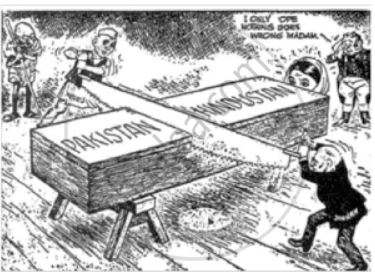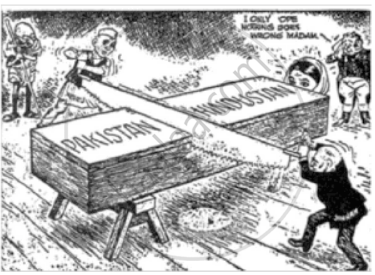Advertisements
Advertisements
Question
Analyse any six consequences of the partition of India in 1947.
Solution
The year 1947 was the year of one of the largest, most abrupt, unplanned and tragic transfer of population which human history has known.
- There were killings and atrocities on both sides of the border. Cities such as Lahore, Amritsar and Kolkata (Calcutta) became divided into 'communal zones'. Muslims would avoid going into an area where mainly Hindus or Sikhs lived and vice versa.
- Minorities on both sides of the border fled their home and often secured temporary shelter in 'refugee camps'. They travelled to the other side of the new border by all sorts of means, often by foot. Even during this journey, they were often attacked, killed or raped. Thousands of women were abducted on both sides of the border. Often women were killed by their own family members to preserve the 'family honour'. Many children were separated from their parents.
- People who managed to cross the border did not have a place they could call home. For lakhs of these 'refugees', the country's freedom meant life in 'refugee camps' for months and sometimes for years.
- Partition was not merely a division of properties, liabilities and assets, or a political division of the country and the administrative apparatus. Also divided were things such as tables, chairs, typewriters, paper-clips and books.
- Even after large-scale migration of Muslims to the newly created Pakistan, the Muslim population in India accounted for 12% of the total population in 1951. The Partition had already created severe conflict between the two communities.
Above all, it was a violent separation of communities who had hitherto lived together as neighbours for centuries.
RELATED QUESTIONS
Which among the following statements about the partition is incorrect?
(a) Partition of India was the outcome of the “two-nation theory”.
(b) Punjab and Bengal were the two provinces divided on the basis of religion.
(c) East Pakistan and West Pakistan were not contiguous.
(d) The scheme of Partition included a plan for transfer of population across the border.
What were the consequences of the Partition of India in 1947?
The main reason for India’s partition is:
Read the given passage carefully and answer the question that follows:
Thus it was decided that what was till then known as ‘India’ would be divided into two countries, ‘India’ and ‘Pakistan’. Such a division was not only very painful but also very difficult to decide and implement. It was decided to follow the principle of religious majorities. This basically means that areas, where the Muslims were in majority, would make up the territory of Pakistan. The rest was to stay with India. The idea might appear simple, but it presented all kinds of difficulties.
Why did the partition of India in 1947 prove to be very painful?
Read the given passage carefully and answer the question that follows:
Thus it was decided that what was till then known as ‘India’ would be divided into two countries, ‘India’ and ‘Pakistan’. Such a division was not only very painful but also very difficult to decide and implement. It was decided to follow the principle of religious majorities. This basically means that areas, where the Muslims were in majority, would make up the territory of Pakistan. The rest was to stay with India. The idea might appear simple, but it presented all kinds of difficulties.
What major difficulty/difficulties arose in the way of partition?
Observe the diagram below and answer accordingly.

Who propounded the ‘two nation theory?
Observe the diagram below and answer accordingly.

On what basis was the two-nation theory proposed?
Which among the following statements about the partition is incorrect?
British India was divided into British Indian provinces and princely states. Consider the following statements in this regard.
- British Indian provinces were directly governed by the British East India Company.
- Princely states enjoyed full control over their internal affairs but not on issues related to foreign relations.
Choose the incorrect statements
Who among the following influence British to come to India?
How many princely states were in India at the time of its independence?
Who propounded two-Nation theory?
The concept of 'two-nation theory' was based on ______.
Which of the following were the problems faced at the time of Partition of India?
Muslim population in India in 1951 was ______.
Which statement about the consequence of partition is correct?
Writers and poets described partition of India as ______.
Highlight any three problems faced by Government of India immediately after independence related to the displaced population.
